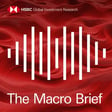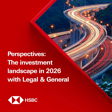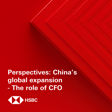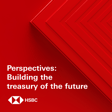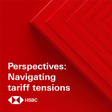Become a Creator today!Start creating today - Share your story with the world!
Start for free
00:00:00
00:00:01

Under the Banyan Tree - Asia and the trade boom: Has the cargo ship sailed?
With the peak-pandemic trade surge a thing of the past and freight rates plummeting, Fred Neumann talks to Shanella Rajanayagam and Parash Jain about the outlook for shipping and trade, and what it could mean for export-reliant Asian economies. Disclaimer. To stay connected and to access free to view reports and videos from HSBC Global Research click here
Hosted on Acast. See acast.com/privacy for more information.
Transcript
Introduction and Access
00:00:00
Speaker
Welcome to HSBC Global Viewpoint, the podcast series that brings together business leaders and industry experts to explore the latest global insights, trends, and opportunities.
00:00:11
Speaker
Make sure you're subscribed to stay up to date with new episodes.
00:00:14
Speaker
Thanks for listening, and now onto today's show.
00:00:16
Speaker
This is a podcast from HSBC Global Research, available on Apple Podcasts and Spotify.
00:00:22
Speaker
Search for HSBC Global Viewpoint or join us via the HSBC Global Banking and Markets page on LinkedIn.
00:00:29
Speaker
However you're listening, analyst notifications, disclosures and disclaimers must be viewed on the link attached to your media player.
Meet the Experts
00:00:45
Speaker
Hello and welcome to another edition of Under the Banyan Tree, where we put Asian markets and economics in context.
00:00:51
Speaker
My name is Fred Newman, Chief Asia Economist at HSBC.
00:00:55
Speaker
And while my regular co-host Harold van der Linde is still away, I'm joined today by trade economist Shanela Rajanayagam in London and later by Global Shipping and Ports Research Head Parash Jain here in Hong Kong.
00:01:08
Speaker
That should give you a pretty good idea of what we're discussing in today's podcast.
Asia's Export Dynamics
00:01:12
Speaker
Exports, of course, are critical to growth here in the Asia region, but are the good times fading?
00:01:18
Speaker
We'll be discussing that and a whole lot more in this episode on shipping and trade in Asia and beyond.
00:01:24
Speaker
So step into the shade and join us under the banyan tree.
00:01:33
Speaker
A bit of context for you before we kick off the conversation.
00:01:37
Speaker
Trade was a really rare bright spot during the pandemic.
00:01:40
Speaker
Even as demand for services crumbled, we saw appetite for goods soaring, which of course was good news here in Asia, where a great many of these consumer goods are actually manufactured and then exported.
00:01:53
Speaker
Now, currently globally, we've seen export volumes are still up about 5% year-over-year.
00:01:59
Speaker
But in terms of manufacturing, the cracks are already starting to show with orders now in contractionary territory.
00:02:06
Speaker
Add to this the fact that Asian exporters are often exposed to highly cyclical industries, and it all points to a looming trade recession that threatens to drag on economic growth.
00:02:16
Speaker
Joining me now to talk us through all of this is our trade economist Janela Rajanayagam.
00:02:22
Speaker
Shanela, great to have you with us.
00:02:24
Speaker
Thank you for having me.
Trade Boom and Logistics Challenges
00:02:26
Speaker
Shanela, paint us the big picture here.
00:02:29
Speaker
How big was really the latest trade boom?
00:02:31
Speaker
We've seen headlines about container shipping shortages in many parts of the world.
00:02:38
Speaker
How does this compare in a historical context?
00:02:41
Speaker
Yes, so I think the only way to really describe the trade boom over the past couple of years has been quite extraordinary because that's really what it was.
00:02:51
Speaker
Even though we had a lot of supply chain disruption, we did also have surging trade volumes,
00:02:58
Speaker
And so mainly over the past couple of years, consumer demand was very strong from Western consumers for the likes of things like pandemic-related products, electronic goods.
00:03:09
Speaker
And this was really supported in part by sizable fiscal stimulus measures in some parts of the world, mainly in the U.S.
00:03:17
Speaker
So all this essentially caused global goods trade to rebound more strongly than expected in the second half of 2020.
00:03:25
Speaker
It's also worth noting that mainland China was very quick to actually restart production given their initial supply chain disruptions.
00:03:34
Speaker
But of course, at the same time, we did have a lot of disruption with logistics.
00:03:39
Speaker
So it was mainly to do with land side logistics rather than shipping per se.
00:03:44
Speaker
But there was a lot of shortages and labor and equipment and some of the key ports around the world.
00:03:50
Speaker
And so this essentially led to a huge backlog of containers.
00:03:55
Speaker
So the way you describe this is an unprecedented sudden demand for goods that was so large it put stress on global logistics networks.
00:04:05
Speaker
But now lately you've been talking about the risk of a trade whiplash.
00:04:10
Speaker
What do you mean by that?
Risks of Excess Supply in Trade
00:04:12
Speaker
Yes, so over the past couple of years, a lot of businesses tried to build up some buffer stocks in anticipation of further consumer demand.
00:04:22
Speaker
And now that we are seeing the trade cycle starting to turn, there is certainly a risk that there could be a bit of payback for those businesses.
00:04:30
Speaker
They might have overdone it and they could essentially be left holding excess supply as goods demand normalises.
00:04:38
Speaker
And the reason we do think that the trade cycle is starting to turn is for three key reasons.
00:04:44
Speaker
The first is that this pandemic induced trade boom is bound to fade.
00:04:48
Speaker
We're not buying the types of goods that we did previously.
00:04:51
Speaker
Secondly, inflation.
00:04:54
Speaker
So prices are continuing to soar, particularly in Western economies.
00:04:58
Speaker
That could lead some consumers to actually cut back on certain spending.
00:05:02
Speaker
And lastly, this idea of stocked up inventory.
00:05:05
Speaker
So the shift from just-in-time manufacturing to just-in-case manufacturing over the past couple of years, it essentially means that some of these businesses do have excess supply and they have to look at ways to deplete that going forward.
Globalization and Trade Protectionism
00:05:19
Speaker
So what signs are you seeing then in the data now that there is a crack in trade, that things are breaking lower, if you will?
00:05:28
Speaker
The WTO, for example, just cut its forecast for global export volumes.
00:05:33
Speaker
Is that something you see in the data as well?
00:05:35
Speaker
And what are some of the indicators that you're watching right now?
00:05:39
Speaker
That's right.
00:05:39
Speaker
So some of the indicators that we look at are the PMIs, for instance, and you do see that contraction in new export orders continuing over recent months.
00:05:50
Speaker
And when we look at that by sector, new export orders actually fell for all key sectors that we monitor in August.
00:05:57
Speaker
And that's the first time that that's happened in over two years.
00:06:00
Speaker
So yes, very similar to the WTO, we do expect trade growth momentum too slow both this year and next year.
00:06:07
Speaker
And which sectors are especially exposed?
00:06:11
Speaker
And not just the sectors, but also which economies should we think of that might be more exposed than others?
00:06:17
Speaker
So I do think it's those sectors that are tied to consumer spending.
00:06:22
Speaker
So things like clothing, perhaps toys, household items as well.
00:06:28
Speaker
You do also see evidence in the data that the electronic cycle is starting to turn.
00:06:32
Speaker
So there could be a bit of a slowdown in semiconductor demand.
00:06:36
Speaker
And in terms of those economies, it really is those that supply these types of goods.
00:06:42
Speaker
So the economies that we do see as most exposed to Western consumer demand, particularly US demand, are markets like Mexico, India and even China.
00:06:54
Speaker
So some downturn in global trade and challenging headlines all around.
00:07:00
Speaker
But taking a step back, it's sort of very easy to get gloomy about globalization.
00:07:06
Speaker
And I know you've done a lot of analysis on this.
00:07:09
Speaker
Where do you stand on this idea of
00:07:12
Speaker
We're seeing the beginning of a deglobalization wave.
00:07:15
Speaker
How structural is this decline in trade?
00:07:19
Speaker
Should we worry about the reversal of some of the trends that we've seen over decades?
00:07:25
Speaker
Well, overall, I think I'm a bit more optimistic and I think there are important nuances between saying that there is this complete retreat from globalisation versus more of a reconfiguration in globalisation, which I think the latter is what we are starting to see.
00:07:41
Speaker
I mean, it is very clear that the days of hyper-globalisation are behind us.
00:07:47
Speaker
Trade openness, which is a metric that we track, has retreated since the global financial crisis and then ticked down even further.
00:07:54
Speaker
as US-China trade tensions started to escalate.
00:07:58
Speaker
But on a more positive note, we are in a very globalised world today, so average tariffs are incredibly low.
00:08:05
Speaker
The risk, of course, is that this has now given rise to new forms of trade protectionism, and certainly post-pandemic there is a risk that businesses and governments increasingly look to shore up their supply chains.
00:08:18
Speaker
and that governments do use industrial policy, which can be slightly protectionist.
00:08:24
Speaker
But overall, I think this is not necessarily the end of globalization.
00:08:29
Speaker
It's simply another evolution.
00:08:32
Speaker
Perhaps we could start to see a bit more trade between countries in the same region.
00:08:37
Speaker
Already intra-regional trade in Asia has been increasing over time.
00:08:41
Speaker
And as businesses look to diversify or even shorten their supply chains,
00:08:46
Speaker
this could help lead to increased regionalization.
00:08:50
Speaker
And it's always commonly said among economists, I think that unless you have trade deals that drive forward liberalization, inevitably the global trade system gums up and protectionist measures proliferate.
00:09:04
Speaker
So we need more trade liberalization to drive globalization forward.
Upcoming Trade Deals in Asia
00:09:08
Speaker
Do you see any sort of pending big deals coming through?
00:09:11
Speaker
Is that even possible in this environment?
00:09:14
Speaker
That's right.
00:09:15
Speaker
And some of these trade deals could actually help drive regionalisation as well, particularly in the Asia-Pacific, which has been quite prolific in striking new trade deals.
00:09:26
Speaker
I think the ones to flag are the ASVP trade deal, the Regional Comprehensive Economic Partnership that took effect at the beginning of this year.
00:09:34
Speaker
There could potentially be more economies to join that, which is anchored by mainland China.
00:09:40
Speaker
There is also the CPTPP, the Comprehensive and Progressive Agreement for Trans-Pacific Partnership.
00:09:48
Speaker
Again, a very Asia-Pacific focused trade deal.
00:09:52
Speaker
The UK is looking to accede to the deal.
00:09:55
Speaker
Both mainland China and Taiwan also have their applications in train.
00:10:01
Speaker
And then also to mention India.
00:10:03
Speaker
So it has typically shied away from engaging in free trade deals in recent years, but it is increasingly looking to strike a number of early harvest deals.
00:10:12
Speaker
It recently did one with the UAE and is also looking to conclude one with the UK this month.
00:10:19
Speaker
So plenty of trade deals in the region to keep an eye out for.
00:10:24
Speaker
Shanela, thank you very much for your insights.
00:10:27
Speaker
Thank you.
Impact of Freight Rate Changes
00:10:28
Speaker
We're going to take a quick break now.
00:10:30
Speaker
When we come back, we'll be joined by Global Head of Shipping and Ports Research Parish Jain to discuss the impact of slowing exports on the container shipping industry.
00:10:49
Speaker
Welcome back.
00:10:50
Speaker
So we've discussed the big picture for global trade.
00:10:53
Speaker
Now it's time to zero in on the outlook for container shipping specifically.
00:10:57
Speaker
Some key stats here before we dive in.
00:11:00
Speaker
Freight rates, for example, have fallen about 50% since July.
00:11:04
Speaker
That's a massive, I think, what, 7.5% per week or so in declines.
00:11:08
Speaker
And that would actually mean that
00:11:10
Speaker
By the end of the year, spot rates on container shipping are probably down to the 2019 average, which is a big decline, of course.
00:11:18
Speaker
But joining me now to discuss this further is our global head of shipping and ports research, Parish Jain.
00:11:25
Speaker
Welcome, Parish.
00:11:26
Speaker
Thank you, Fred.
00:11:27
Speaker
Good to be here.
00:11:28
Speaker
So, Barish, paint us a bit of a picture of what's going on in the container world.
00:11:32
Speaker
You had the boom of a lifetime, I imagine, the last two years.
00:11:36
Speaker
Is that really fraying now in the last two months?
00:11:39
Speaker
What's really happening there?
00:11:40
Speaker
Absolutely.
00:11:41
Speaker
I mean, we have seen freight rates for certain routes, especially has jumped as much as tenfolds in March of 2021 versus 2019.
00:11:51
Speaker
but as the higher energy prices and the fear of global recession started to impact the global trade outlook, that coincide with some ease of congestion means that freight rates are reverting back to the mean rather rapidly.
00:12:07
Speaker
So yes, as you said, freight rates has declined 50% over the last couple of weeks, but they are still more than double of 2019 level.
00:12:15
Speaker
So yeah, there is some way to go before we expect some sort of sanity return back among the players in this sector.
00:12:21
Speaker
And so it's a really famously cyclical industry, right?
00:12:25
Speaker
Shipping, we have boom and bust periods over years.
00:12:29
Speaker
How do you look at the next year then?
00:12:31
Speaker
Are we really seeing that big shipping bust after an unprecedented boom?
00:12:36
Speaker
Or are you somewhat more optimistic that we're finding a floor here over next 12 months or so?
China's Economic Influence on Shipping
00:12:42
Speaker
So this is the exact question that we went ahead and answered in our last sector note, Back to Earth.
00:12:48
Speaker
And what we are saying at this point of time that we expect the shipping company's profitability to decline as much as about 80% in 2023 versus 2022, but they still remain very comfortably profitable.
00:13:01
Speaker
And to your point about the bust...
00:13:04
Speaker
the amount of money that they have made in the last two years, it probably will need several years of losing money before they get to the birth situation indeed.
00:13:13
Speaker
Now, we always talk about container shipping, right?
00:13:16
Speaker
But there's another segment that's quite important.
00:13:19
Speaker
That's the bulk carriers.
00:13:20
Speaker
And I imagine China, Chinese demand plays a huge role there.
00:13:24
Speaker
Now, of course, China's economy slowed down very sharply over the past year or so.
00:13:30
Speaker
How is that playing out in your space in terms of bulk carriers?
00:13:35
Speaker
Are spot rates down just as much as in container?
00:13:37
Speaker
And how do you look at that sector going forward?
00:13:41
Speaker
Yeah, absolutely.
00:13:42
Speaker
I mean, in terms of volatility, the freight rate volatility is not materially different from what we have seen in case of container shipping.
00:13:51
Speaker
So if you look at BDI, it's a Baltic Dry Index, which is kind of a barometer of assessing the freight rate for the bulk commodities.
00:13:59
Speaker
They have also declined to the tune of 60 odd percent from the peak.
00:14:04
Speaker
But from the trough a few weeks back they have almost doubled as well.
00:14:08
Speaker
So this is as volatile as it can get.
00:14:11
Speaker
And unlike container, China is very, very critical for the dry bulk demand, particularly for the major bulk like iron ore and coal.
00:14:23
Speaker
And a slowdown in the property sector in particular in China already had a bearing on the capesize demand.
00:14:29
Speaker
So there is a lot of hope pinning up on Chinese stimulus.
00:14:32
Speaker
And if that can do the similar sort of magic that we have seen in the previous cycle, but time will tell.
00:14:39
Speaker
Of course, as an economist, I'm heartened by your comment that the bulk spot rates are starting to increase because it might suggest actually the demand in China is picking up.
00:14:48
Speaker
And then we might see a bit more growth hopefully coming through in China.
00:14:52
Speaker
Certainly, we expect a bit of a pickup there.
00:14:54
Speaker
But I want to shift gear a little bit.
Airline Industry Recovery in Asia
00:14:57
Speaker
You also head up our Asian transport research team.
00:15:01
Speaker
And, you know, we've seen the airline industry in Asia, as elsewhere in the world, go through a tough time.
00:15:07
Speaker
Passenger traffic being down, of course, because of the pandemic.
00:15:10
Speaker
Now we see some reopening coming through.
00:15:13
Speaker
Economies like Korea and Japan are starting to relax some of their travel controls.
00:15:18
Speaker
Are you optimistic on sort of a rebound for that sector in Asia, given that tourism
00:15:23
Speaker
likely will pick up quite a bit.
00:15:25
Speaker
I'm absolutely confident about that.
00:15:28
Speaker
In our view, the old habits die hard.
00:15:30
Speaker
There are enough evidence which showed us that as soon as we have seen control over the COVID cases domestically, the travel demand returned back to the 2019 level.
00:15:40
Speaker
We have examples of Europe and US which are ahead of us in terms of reopening and we have seen a strong pent-up demand not only for the Leaser but also for the business.
00:15:49
Speaker
If anything, going into the winter, going into the Chinese New Year next year, it's probably whether the airlines will be able to cope with the demand.
00:15:58
Speaker
A lot of pilots, a lot of the crew still needs to be hired, need to be retrained and probably capacity constrained which is probably a good problem to have from the airlines profitability perspective.
00:16:09
Speaker
Well, capacity constraints, good from an airline perspective, less so from somebody who's desperately trying to book their holiday on the beach somewhere.
00:16:16
Speaker
Thank you, Parish, for all your insights.
00:16:18
Speaker
I'm sure we'll come back to you in the coming months to get another read on the transport and logistics sector globally.
00:16:24
Speaker
Thank you.
00:16:25
Speaker
Absolutely.
00:16:25
Speaker
Thanks, Fred, for having me here.
Conclusion and Preview
00:16:32
Speaker
Well, I'm sure we could keep this conversation going for a lot longer, but unfortunately we're running out of time.
00:16:37
Speaker
Many thanks to Parash and Shanela for joining us.
00:16:40
Speaker
Many thanks to all our listeners as well for tuning in.
00:16:43
Speaker
I'll be hitting the road again next week, but Harold will soon be back here in Hong Kong ready to tackle another topic right here under the banyan tree.
00:16:55
Speaker
Thank you for joining us at HSBC Global Viewpoint.
00:16:59
Speaker
We hope you enjoyed the discussion.
00:17:01
Speaker
Make sure you're subscribed to stay up to date with new episodes.
